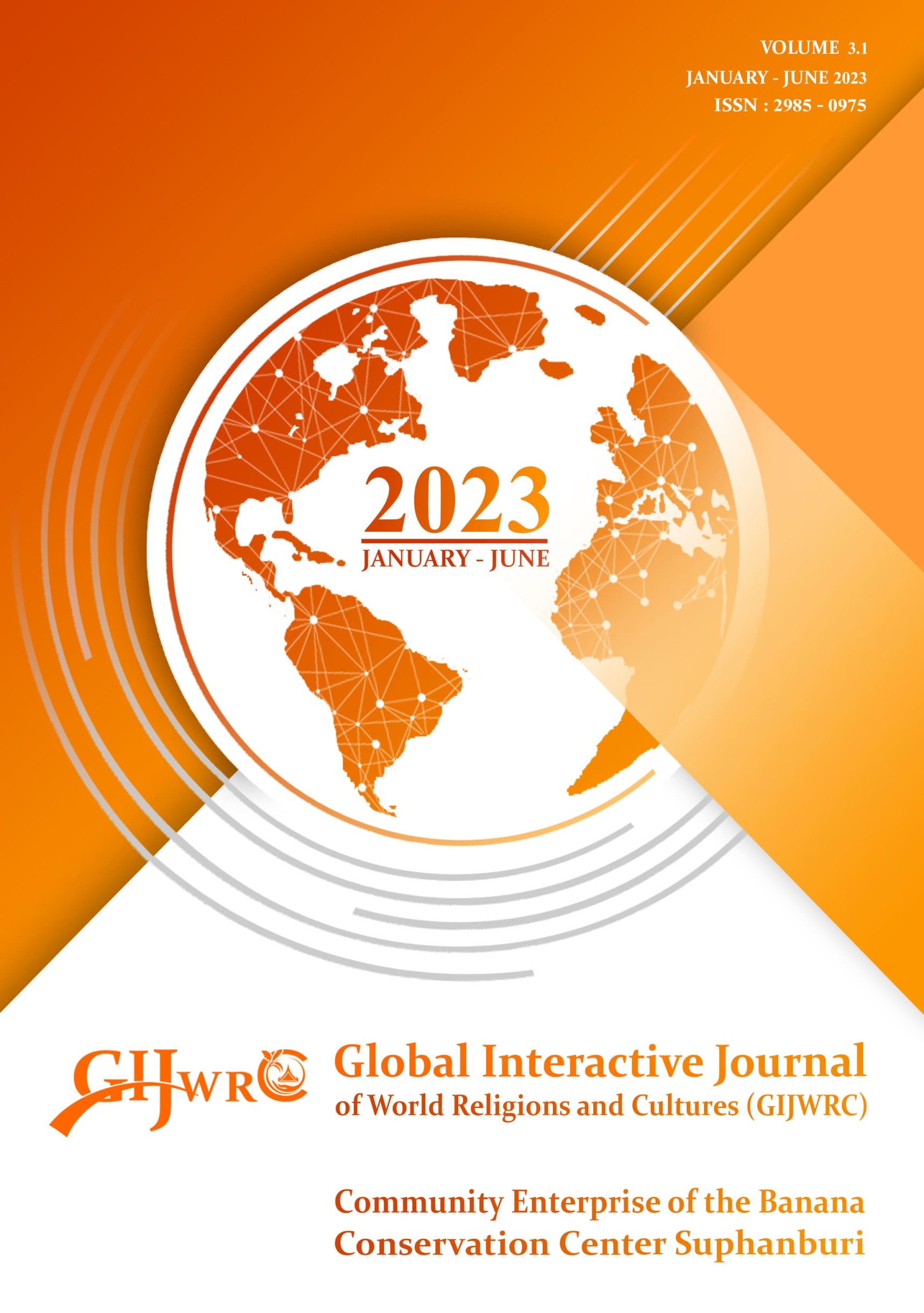THE STUDY OF U-THONG CITY: HISTORY OF BUDDHIST PROPAGATION
Main Article Content
Abstract
The history of the Buddhist missions in the U-thong city, its influence and the Buddhist footprints during the Dvaravati era (U-thong) from the testimonial works of art. Due data were collected from the Tipiṭaka, the Aṭṭhakathā, the archeological evidences, literatures and related researches. The researcher found that Buddhism was expanded to the U-thong land and through archives, the archeological scholars believed that the U-thong history has ever welcomed the Indian traders (Iron Age) since the 3rd Buddhist Century. However, with evidences, the archeological, sculptural, architectural and inscriptional scholars found that the Buddhist missions arrived around the 8-10th Buddhist Centuries for they found clay sculptures of three monks with monkhood frock and holding bowls for alms gathering. They were the oldest testimonies ever found compared to other sites. Later Buddhism took firmly deep rooted in the mind of its followers. This led to the creation of arts, cultures, customs, and refined religious rites in the site of the ancient U-thong city which were very during the 11-16th Buddhist Centuries, witnessed in “Dvaravati Arts”. It was seen that the U-thong city was older than any other cities in the ancient Dvaravati Age since this was the major trade center and the center of Buddhism in the first Dvaravati State era showing the footprints of the influences of the Brahman and Buddhism such as the stupas, the Dhammacakra stones, the pagodas, the printed Buddha images, the Buddha images and other inscriptions related to the Buddhist principles. It well heralded the Buddhist prosperity.
Article Details
References
Boeles, J.J. (1967) “A note on the ancient city called Lavapura.” Journal of the Siam Society, Vol. LV, Part I (January 1967).
Chin Yoodee. (1966). “Pre-history of Muang U-thong”: Archeology of Muang Uthong. The Department of Fine Art.
Department of Fine Art. (1988). Archeological Sites of Thailand. Bangkok: Agricultural Cooperative Federation of Thailand, Vol I, pp. 121-29; l II, pp. 90-250.
Indrawooth Phasook, (2008). Dbaravati Dharmacakra. Bangkok: Saksopa Press.
Jira Jongkol. (1967). Phra Nakhon National Museum. The Department of Fine Art printed on the occasion of His Majesty inaugurated Phra Nakhon National Museum, dated, 25 May 1967.
Mom Chao Subhadaratis Tissakul. Former Dean of Faculty of Archeology. (1966). Archeology of Muang U-thong, (1966). Silapakorn University. Department of Fine Arts, collected and printed on the occasion of the royal inauguration of the U-thong National Museum: Suphanburi, 13 May 1966.
Phasook, Indrawooth. (1999). Dvāravatī: Analytical studies of the Archeological Evidences. Bangkok: Aksorn Samai Printing.
Phasook, Indrawooth. (2005). Suvarnabhumi from the Archeological Evidences. Bangkok: Silpakorn University.
Phitoon Maliwan and Sawai Malathong, (1999). History of Buddhism. Bangkok: Religious Affairs Printing, p. 1.
Phra Brahmagunabhorn (P.A. Payutto), (2013). Dictionary of Buddhism. 25th.ed. Bangkok: Office of Palidhamma Printing, pp.114-115.
Phradhamma Piṭaka, (P.A. Payutto) (2011). Upon Normalcy Arrives; Know Soonest and Do It Right. Dhamma Writing. 1 January 2011, p. 494.
Phradhammapiṭaka, (P.A. Payutto), (2004). Merit Pilgrimage-Dhamma Inscriptions. 10th ed. Bangkok: Phim Suay Company Limited.
Prapass Choowichian. (2013). “The Site of the Sank Ships at Vat Klang Glong, Samut Sakhon: New Information to Global Trade under the Mud Sea.” Siam Rat Weekly Reviews, 27 December 2013.
Prof. Luong Paripāl Paribhaṇḍ. (1960). Archaeology. Phra Nakhon: Roongruangrat. p.34.
Prom Suthas Na Ayudhya. (1968). Buddhism Rooted at Ban Khoo Bua, Muang, Ratchaburi Province during King Asoka the Great until His Majesty King Kanissaka from BE 273-703. Bangkok: Charoendhamma Printing.
Sakdhichai Saaisingh, Asst. Prof. Dr. (2004). The Dvāravatī Arts: The Early Buddhist Culture in Thailand. the 2nd ed. Bangkok: Dan Suddha Printing, pp.61-74.
Sakdhichai Saaisingh, Asst. Prof. Dr. (1972). Geo-history of Buddhism. 1st ed. Phimrak, Bangkok: Bannakhan Printing, p.2.
Sathien Phothinantha, (1972). Geo-history of Buddhism. Bangkok: Bannakhan Printing, p.2.
Siriwat Khamwansa, Assoc. Prof. (1999). The History of Buddhism in Thailand. The 4th ed. Bangkok: Charansanitvongs Printing company Limited, pp.1-8; p. 20.
Somdej Phra Chao Borromawongther Khrom Phraya Damrong Rajanuphab (1962). The Buddha Chetiya Legend. Bangkok: Teachers' Council of Trade Organization, pp.124-127.
Somdej Phra Vannaratana. (1971). Phraya Pariyattidhammadhada (Pae Tallaksana) (trans.2015) Saṇgītiyavoṇs. Chronicles on The Dhamma Canon Revise Congress. Bangkok: The Saṇgha School of Vat Phra Jetuphon, pp.46-75.
Srisakkara Vallibhodom. Assoc. Prof. Dr. (1996). Siam Country: Background of Thailand since the Primeval Age until the Ayudhya Period – Kingdom of Siam. 3rded. (Revised), Bangkok: Matichon.
Srisakkara Vallibhodom. Assoc. Prof. Dr. (2009). Evidence Books of Archeological History. Academic seminar on Muang U-thong an Ancient City to Create the Tourism of Old History, Culture and Ways of Life.
Sujitt Wongthes, Prof. (2005). Where Was Sukhothai From? Bangkok: Phimdee Company Limited, pp. 74-77.
Sujitt Wongthes, Prof. (2006). Suvarnabhumi: the original current of the Thai history. Bangkok: Phimdee Company Limited, p.12.
Thaksin Indrayotha (1991). Who are the Local Chiefs of the Chao Phraya River Basis and the Golden Ax Handle in the Recent 2,000-3,000 Years? Bangkok: Dan Suddha Printing. p. 14.
Vinai Phongsripien, Dr. (2000). Teachers and the Thai Historical Instructions. A manual to organize activities on historical instructions, how history is taught, Bangkok: Department of Religious Affairs Printing, p. 2


